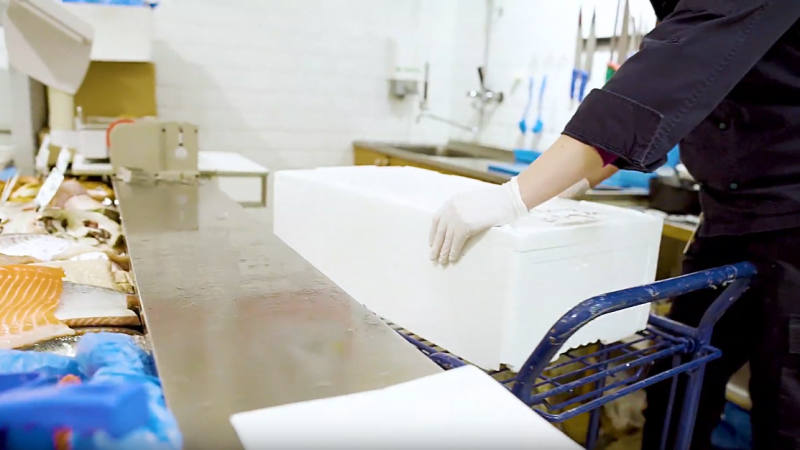EPS – expanded polystyrene – is a lightweight and environmentally friendly material consisting of 98% air and 2% polystyrene (plastic). In Denmark, it is known under the brand name Flamingo.
- EPS is approved for direct contact with foodstuffs in both the EU and the US.
- Fish boxes made of EPS have the best insulating properties.(1) No other material can ensure that fish is kept refrigerated in a similar manner. This is key to maintaining food security.
- The report Survey of Polystyrene Foam (EPS and XPS) in the Baltic prepared by COWI and the University of Aarhus on behalf of the Danish Ministry of Environment and Food concludes that the best alternative to EPS fishing boxes is a cardboard fishing box, which has poor insulating value, and which is coated with PE laminate on the outside and PET laminate on the inside. A box composed of two plastic fractions as well as cardboard is difficult to recycle.(2)
- The US organisation Sustainable Packaging Coalition has established eight criteria for sustainable packaging. EPS fish boxes are able to live up to all of these if the buyer of the boxes cooperate on recycling and demanding renewable energy in the production of EPS fish boxes.
- EPS fish boxes for 5 kg of fish weigh 130 g while EPS boxes for 20 kg of fish weigh 565 g. EPS fish boxes weigh approx. 2.8% of the weight of the fish transported.
- Fish boxes made from other materials all weigh considerably more. Typically, 3-5 times as much as EPS fish boxes.
- The lower weight means lower fuel consumption and thus lower CO2 emissions. Fish boxes weighing 3.5 times EPS boxes require more than 3 times as much fuel and emit more than 3 times as much CO2. This corresponds to more than 3% of the total freight.(3)
- Production of alternative packaging increases our use of the planet’s resources. For example, 12 times as much water, 36 times as much electricity, and various chemicals are used when alternatives to EPS packaging are produced in cardboard compared to EPS. (4) The European trade association, EUMEPS, has previously carried out analyzes of fish boxes, which show that fish boxes of EPS have environmental and climatic benefits compared to alternatives. (5)
- Used EPS can be compacted by a factor of 40 or more and EPS is 100% recyclable. Compacted EPS boxes can be sold for recycling for up to EUR 800 per tonne.
- The recycling rate for EPS fish boxes is in several countries estimated at 90%. Other boxes are often energy recovered.(2)
- For every 1 kg of EPS that is recycled, 2 kg of oil, over 5 kg of CO2 emissions and 46 litres of water are saved.(6)
- The report Survey of Polystyrene Foam (EPS and XPS) in the Baltic prepared by COWI and the University of Aarhus on behalf of the Danish Ministry of Environment and Food concludes that extremely limited quantities of EPS fish boxes end up in the marine environment. The worst-case estimate is that less than 0.01% of EPS from fish boxes end up in the sea. The best-case estimate is that as little as 0.001% of EPS from fishing boxes, equivalent to 200 kg, end up in the sea. This is from all countries in the Baltic Sea region. In other words, Sweden, Finland, Russia, Estonia, Latvia Lithuania, Poland, Germany and Denmark.(2)
Sources
(1) http://www.matis.is/media/matis/utgafa/03-17-Effects-of-packaging-solutions.pdf & http://www.fishboxes.info/lateststudies.html
(2) Survey of Polystyrene Foam (EPS and XPS) in the Baltic
(3) Calculated through http://gronberegner.teknologisk.dk/
(4) see https://eps-airpop.dk/en/2020/03/eps-fish-boxes-the-sustainable-choice-psfoamfacts/
(5) https://eps-airpop.dk/wp-content/uploads/2019/04/LCA-Fish-Box_aktuell.pdf
(6) CO2 emission and water saving require that the recycled EPS is not replaced by other fossil heating/burning but by a CO2-neutral energy/heat source. If we only look at recycling of EPS, the gain is just under 2 kg of CO2. If EPS is recycled in a closed loop where the foamed EPS does not need to be compacted, an additional 1 kg of CO2 can be saved https://www2.mst.dk/Udgiv/publikationer/2019/08/978-87-7038-094-2.pdf For further information, see www.eps-airpop.dk

